 Go
to the Archive index
Go
to the Archive indexFrom his workshop at the back of The Tiger's Head in Wolverhampton, the innkeeper's velocipedes and bicycles built from 1868-80 were to set a course for one of the greatest brands of motorcycling history - for this man was Daniel Rudge! In 1891, the further name from Charles H Pugh's (of Atco lawnmowers fame, from Atlas Chain Co.) Whitworth Cycle Co. was added, while the 'Red Hand' trademark became adopted from the badge of Ulster. It would seem our particular story begins at the end, as this prestigious manufacturer entered into receivership in March of 1933, though it continued trading with a board of directors reformed on the 6th April 1934, under the imposing presence of Edward de Stein, also sitting as Chairman of The Gramophone Company Ltd, manufacturers of radio equipment and records under the label of "His Masters Voice". At the passing of John Vernon Pugh in 1936, managing director since 1891, control of the company's destinies wholly passed to these new masters. The traditional HMV label shortly gave way to the brand of EMI, the old Coventry home was sold off, and during 1938 all works consolidated to a compact factory adjacent to the main plant at Hayes in Middlesex. In the summer of 1939 it was announced that the product range was to be joined by a most untypical lightweight aimed at the popular economy sector. After a glorious history of sporting achievement, the unthinkable had happened: Rudge was making an autocycle!
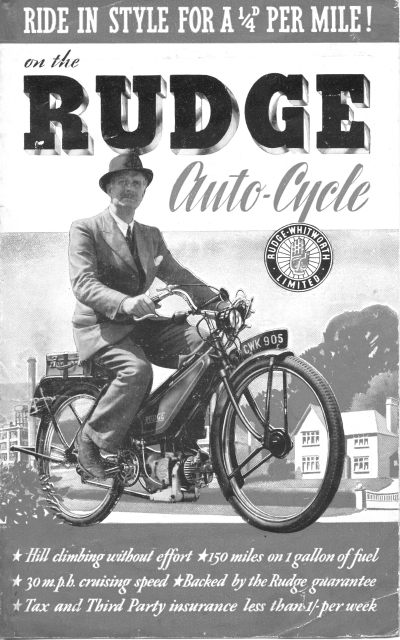
Cover of the 1939 Sales Brochure
The newcomer was offered in two forms: the rigid framed Standard, or the rigid framed De-Luxe, being exactly the same machine with additional engine covers! However, even before any machines had actually left the factory, prospects for Rudge's new autocycle were about to be rudely interrupted. The dark shadows of fate were falling long in the twilight of the 30s, when at 4:45am on Friday 15th September the opening rumble of thunder from the battleship Schleswig-Holstien pounded the Westerplatte fortress at Danzig and signalled the years of storm to come. The requirement for radio and radar equipment from EMI was to be far greater than the military need for a handful of motor cycles that could more easily be turned out by bigger manufacturers, so on 18th December 1939 The Last Waltz was played on the Rudge assembly line.
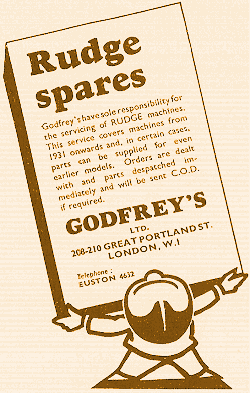
In 1940, as the whole world looked over the precipice of madness, it seemed to EMI that it probably wouldn't want to be making motorbikes again. Since the Hayes assembly became closed so rapidly, there was quite a volume of parts left over. Motor cycle components were cleared as spares to sole agents Godfrey's of Great Portland Street, London, while a licence to continue to assemble Rudge autocycles was issued to Norman at Ashford. Now, considering that Norman's own manufacturing itself became mothballed during the later part of 1940, it should be appreciated that the Rudge autocycle was really only built for a very brief period of less than a year, and obviously in relatively limited numbers. You may also be thinking this is could be about to fall into one of those "lost bike" tales, but there's something about autocycles that seems to make them one of motor cycling's great survivors. There may not have been many Rudges made, but it'd be taking more than a few German bombs to stop the ones that were! The Rudge name must surely be about the most prestigious to ever grace a humble autocycle, and here we have a most impressive de Luxe example to honour today's test. On its debut at the 21st East Anglian Rally, it completed the course, and romped home with 'Best Autocycle' prize, then went on to follow this up later in the year, taking 'Best Lightweight' at the giant Copdock Show - mind you, it hasn't always been in this condition! This de Luxe was first registered in April 1940, and is thought to be one of the last off the Hayes assembly line. Purchased from Redhead & Sons Cycles of Northampton, its lady owner rode the machine all through the war years on WVS work, and laid it up in 1946. Espied on his daily round by the local paperboy in the early 1960s, he finally plucked up the courage to enquire about the redundant bike, and was rewarded by actually being given the very object of his aspirations! Assisted by his father, they did get the motor going again, though it never seemed to run satisfactorily and was only used across the fields before ending up in another barn for the next 37 years. February 2001 saw the autocycle passing on to only its third owners and Rudge enthusiasts, who returned the machine to its original 'maroon super-sheen' magnificence - right down to even reproducing the original dealers transfers on the engine covers. The cycle may have seen relatively little use in its 60 years, but it certainly had plenty of time to deteriorate, so don't be thinking that this was just a spruce up.
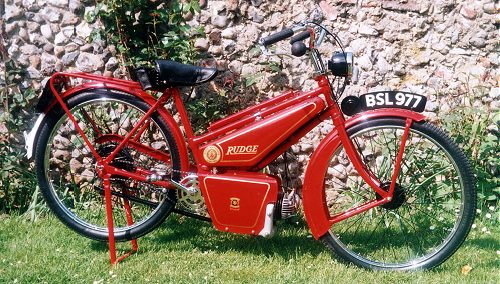
One of the surprising things may be the pre-war fitment of the Junior de Luxe motor in place of the expected Junior. Rudge must have been among the very first customers getting the JDL motor, and all their autocycles were fitted with them. So what's the difference? The Junior has deflector-top piston with single port transfer, single exhaust port and one inlet, which delivers a steady pull at low revs and tops out around 25 - 28mph. The JDL features Schnurle loop, four transfers, two exhausts, and one inlet. Enter the new technology for more power! A little more pull on the hills, a few more available revs, and around 32 - 35mph at your command. As one would probably expect from Rudge, the general attention to correctness is just that bit more detailed than comparative manufacturers. Those engine covers are a fine case in point: the offside is steel, while the flywheel side was made out of brass, since it was felt a steel cover on this side could have disturbed the flux of the magnets! Another original feature was the luxurious introduction of a spring loaded pedal chain tensioner, a principle to become later adopted by many moped manufacturers. This, however, operates rather unusually by springing the chain upward on the return run, but a study of its action by forward and back-pedalling does at least satisfy that it functions capably. The petrol tap is of a push-on/push-off type (without reserve) nestled between the tank and right hand engine cover. The shutter choke is served by a remote control rod running up the port side of the petrol tank, so no need for bending over the low-slung engine to operate this, and it doesn't seem to matter that the same consideration is omitted regarding the flood button on the carb since the motor fires up readily enough on choke alone, despite the cold January day! The trigger-lock clutch, decompressor and throttle levers mount on the handlebars while the front and rear brake levers sprout forwards from their ends. This keeps the bar assemblies looking tidy and organised, though still appears to the modern machinery rider as if you are going to require four hands to operate it all! You can decide to either fire-up on the stand then use the clutch from a standstill, or pedal away to a flying start down the road. We've chosen the former to appraise the motor, which using the throttle lever, can easily be set to tick-over steadily on a cold engine (these old-type controls do have some advantages). The rear stand spring-clips up at the back of the mudguard, and despite the single gear, the motor proves it produces enough torque to achieve a capable unassisted standing start. This is however, unnecessarily laboured and slow, so a boost on the pedals is recommended to make this phase more practical. Having twice the capacity of a moped, hills can be approached most confidently, but vibrations through the pedals become acutely more obvious as the motor works under load. Because of the control arrangements throttle, clutch and braking operations tend to become very separately defined functions. Such actions are certainly slower and feel more deliberate than modern layouts but they so suit the character of the whole autocycle experience. The pull-back handlebars are very leisurely and the suspensionless frame just seems to bounce normal road bumps on its pneumatic tyres. The best part is just burbling along at a constant pace with the throttle lever set like a cruise control - look about and enjoy the ride! Performing best when the motor is nice and hot, its racing heritage shines through as this Rudge autocycle is paced to a TT winning maximum 36mph.
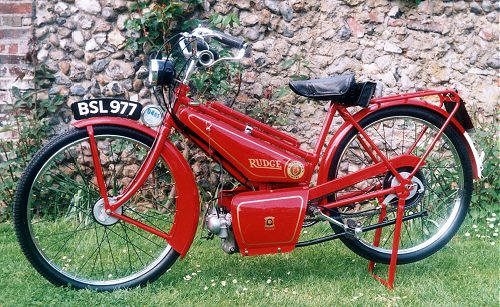
Several differing accounts appear on the closing phase of Rudge, but while the licence issued to Norman certainly existed till 1943, Norman's own manufacturing actually closed for the duration in the autumn of 1940, and was not restarted again until 1946. Into the early years of the war, Norman were making a couple of lightweight motor cycles, and three versions of their own Motobyke autocycle. The Norman Rudges were really only an exercise to build out component stocks, and it is quite possible these last few Rudge autocycles could have become hybrids, as out of necessity to finish, some may have included a number of Norman fittings.
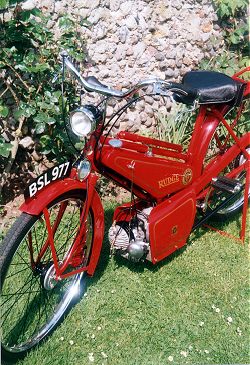
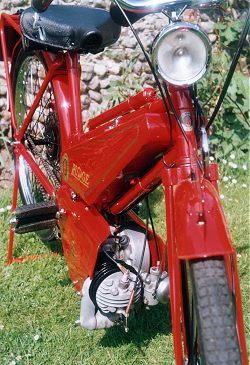
The tune was certainly all played out on the 16th March 1943 in a "Memorandum for the Board regarding Rudge Whitworth Limited". This outlined the government lack of provision for restarting the cycle business at Hayes, the required investment, and view of the poor prospect for profit. As the Ministry of Production had decided that cycle manufacture would become concentrated in the Midlands, and a good offer for the brand lay on the table, EMI sold the Rudge name complete with all rights on its motor cycles, bicycles and autocycles, to become the property of the Raleigh Group - a pit into which many old motor cycling names would eventually fall, never to be seen again! Following enquiries in the later 1990s, Raleigh sold on these rights for just a few hundred pounds... to The Rudge Owners Club.
Introduced at the Winter Gardens Show, Blackpool on 15th May 1963, when right from the first and for several years to come, this machine would dominate home market sales on a scale as never before imagined. What better time but almost to the day of its 40th anniversary to honour this humble giant?
First published, April 2003